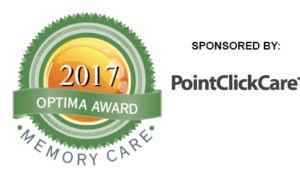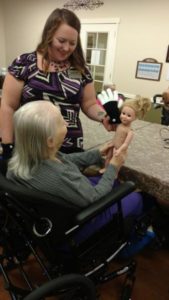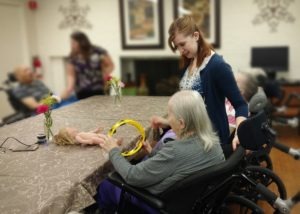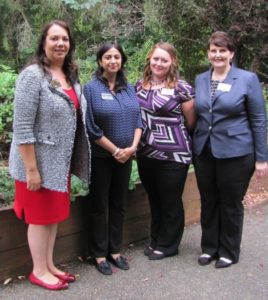2017 OPTIMA Award: The power of No
In 2012, the Centers for Medicare & Medicaid Services (CMS) instituted national mandates to reduce the use of unnecessary antipsychotics for nursing home residents, especially in cases of dementia-related behaviors. CMS’ original goal, touted as a sea change in dementia care practices, was set at a 15 percent reduction over five years.
Issaquah Nursing and Rehabilitation Center, the 2017 OPTIMA Award winner for Excellence in Memory Care, decided 15 percent wasn’t low enough. The facility slashed its antipsychotic medication rate from 34 percent to just 3 percent in less than three years. Issaquah now stands as a model for what can be achieved when organizations ignore the lines in the sand and choose to dig deeper.
How low could your organization’s rates go if you made it a mission instead of a mandate?

Issaquah Nursing and Rehabilitation Center
Nestled at the feet of Washington state’s Squak Mountain, the Issaquah building looks more like an inviting forest lodge than a skilled nursing facility. Founded in 1964, the quiet community has a wall full of accolades attesting to clinical and administrative excellence.
Of the community’s 110 residents, almost half have some sort of cognitive decline. The community also has 22 military veterans and at least a dozen residents with diagnosed mental health conditions.
Prior to 2015, 34 percent of Issaquah’s residents were receiving some sort of psychotropic medication. Like most nursing homes at that time, the medications were usually for controlling unwanted behaviors. Two years later, Issaquah’s use of those same medications has plummeted to just 3 percent.
Achieving the mission took the unequivocal cooperation of administration and nursing—and learning the power of saying “no” on a facility-wide basis.
The journey
When Issaquah’s Administrator Lisa Stubenrauch, RN-BC, BSN, NHA, arrived in 2008, the facility was a very different place. Those with cognitive decline were housed in locked units and antipsychotics were everyone’s go-to solution for behavior control. The dementia wards also included all the behavioral health residents, “which was not a good idea,” Stubenrauch remembers. “Those locked units generated more than 100 incidents—so many I had to hire an incident person to manage them.”
Issaquah’s Director of Nursing Services Jennifer Daley, RN, SWOC, came on board shortly after, and the two formed a fierce bond against the then-rampant and almost whimsical use of psychotropic drugs as a quick fix for dementia behaviors.
In 2015, the Issaquah team launched a radical program to reduce the number of antipsychotic drugs administered to residents. The program required all hands on deck—including the nursing staff, direct-care staff, onsite physicians and eventually even the local hospital emergency room personnel.
Working from the ground up, Stubenrauch and Daley began intensive staff training programs to educate caregivers in the behavior-as-communication approach to dementia. It was a big mind-set shift, Daley recalls. “Some of the legacy nurses here didn’t trust the idea at first, and the hospitalists really fought it.”
As part of the program, all staffers—including the certified nursing assistants (CNAs)—are trained in how to document behaviors and any change of condition directly into the clinical software, introducing data standardization across the caregiver continuum.
One of the first things staffers learn is to never say, “This resident is like this all the time.” All caregivers are expected to look for and document any changes in mood, behavior, appetite and other parameters. All that data matters, because it could provide insight on behavioral triggers and possible clinical causes. It also engages the staff in being an important part of the bigger picture of resident care, Stubenrauch says. “If the staff doesn’t know how important the data they’re documenting is, they won’t take the time to do it accurately.”
Then Daley and Stubenrauch enacted a radical policy: No one on the staff was allowed to order an antipsychotic without Daley’s or Stubenrauch’s express approval. Not even during active outbursts in the dining room. Not even on weekends. And, not even the attending physician was exempt.
None of it was easy. They battled the on-site doctors and those at the local hospital. The battled the families, who would argue, “But Mom has always been on that medication.” They even battled their own nurses, who initially resented the loss of the antipsychotics option in the weekend medication box.

Many thanks to PointClickCare, the sponsor of the 2017 OPTIMA Award for Excellence in Memory Care
But once the incredibly strict program had a chance to gel, staffers began to see its value. “It started as a way to stay out of trouble with CMS and keep a five-star rating,” Stubenrauch recalls. “What changed me was seeing the results. People who were taken off the medications went through something like an awakening. Once I got over the fear of having something bad happen and started to focus on what was really best for the residents, I really dug in my heels.”
Issaquah has physicians onsite three times per week, but that doesn’t help when a resident is taken to the emergency room. Eventually, Stubenrauch asked the hospital providers not to give her nurses antipsychotic prescription orders without her permission. After an initial pushback, they began to see the results and got on board quickly, she says.
Shaily Arya, ARNP, joined the Issaquah team in 2016 eager to share her own passion for reducing overprescribing. She works with a third-party consultant pharmacist to evaluate residents for polypharmacy: “Does everyone really need to be on Prilosec or an antidepressant? I’m so passionate about reducing the pill burden.”
She is zealous about conducting medication reviews, especially when a resident returns from a hospital visit. “So many times residents will come back from the emergency room on antibiotics for a urinary tract infection,” she says. “Did the ER actually test for that? Or, did the resident test positive but is simply colonized? We don’t know.”
Arya works in tandem with Daley and Stubenrauch to evaluate whether a medication is really necessary—and to help the rest of the clinical staff learn how to handle behaviors in nonpharmacological ways. “Babies cry because they can’t tell you what they want. At the other end of life, we do the same thing,” she says. “Would I put a 2-year-old on Seroquel to stop the crying? Of course not.”

Activities Director Chrissy Brockway interacts with resident Patricia and her doll during a Harmony Club session.
Activities intervention
Simply refusing to administer antipsychotics is, of course, only part of the story. Issaquah also needed new ways to engage memory care residents and an arsenal of nonpharmacological alternatives to calm resident agitation, encourage activities of daily living and increase quality of life.
When Chrissy Brockway, ADC, joined the Issaquah team as activities director in 2014, she brought her expertise and research interests in what helps people with dementia become alert and connected. She’s studied strategies in music therapy, light therapy, aromatherapy, Snoezelen rooms and other kinds of sensory stimulation. Lately, Brockway has been experimenting with a tonal therapy called “WholeTones for Healing,” which uses specific tone frequencies to stimulate the brain.
Using the best elements of the above approaches, Brockway created the Harmony Club for residents with advanced dementia, most of whom have lost the ability to speak. The small group of six to 10 residents gathers for one hour three times a week, right after breakfast. As a QAPI project, Brockway and Assistant Activities Director Susie Little developed a chart to document the alertness level of each resident before, during and after the session. The data sheet tracks the spikes in each resident’s engagement and notes what activity or stimulus triggered it.
Brockway and Little work with each resident one at a time. Each resident receives a hand massage at the start of the session since the sense of touch seems to “wake up” even the least connected residents. The rest of the session is a happy melting pot of era-relevant songs, sensory objects, fragrances and individual time outside on the adjacent patio, when weather permits.

Assistant Activities Director Susie Little gives resident Patricia a turn with the tambourine.
They even built their own virtual reality goggles using an old iPhone and a $20 headset. They place different seasonal objects in residents’ hands: crisp leaves in the fall, flowers from the site’s spring garden or fragrant pine boughs overhanging the patio in summer. The aromatherapy unit in the corner adds scents like lavender, citrus, cinnamon and spearmint.
As residents interact, their vacant stares disappear and some even laugh, verbalize or clap hands. Brockway calls it “their daily awakening.”
It’s not just fun and games. The program has increased alertness by nearly 45 percent across the group. The team also has gathered enough data to know which interventions and engagement activities work best for each individual resident, right down to the exact song or object that gives that person the most joy. “Nothing works every day,” Brockway says. “But we talk to the families and ask where they loved to go, what they loved to eat, and then we try to mimic their happy place.”
One resident, Patricia, arrived at the session seemingly in a trance with her head tucked on her chest, eyes vacant, clasping a well-worn doll. But when Little takes her hand and speaks to her, Patricia looks up and smiles with an extra-wide grin. The physical touch has inspired something, and she’s awake and ready to interact. Long after Little has moved on to the next resident, Patricia is still happily interacting with her doll, placing it on the table and comforting it, as if she is changing its invisible diaper. Later, she laughs as she joyfully rattles the tambourine Little has given her.
An hour after the session, Patricia is sitting at a table in the dining room eating her lunch. No one needs to feed her; she’s feeding herself just fine. She laughs and waves to other residents and caregivers as she eats.

L to R: Lisa Stubenrauch, Shaily Arya, Chrissy Brockway and Jennifer Daley
Do the Harmony Club sessions do any good? Patricia may be the proof. Long after the session is over, she is alert and happy. She is able to enjoy her lunch without being hand-fed. She is aware of and interacting with those around her. She may not stay this way all day, but for now, this is what quality of life means.
The common goal
Issaquah’s antipsychotics reduction program may not win any popularity contests, but implementing a similarly strict program could achieve significant results for any provider. Issaquah’s staffers agree that there’s a method to success, and it begins with the conjoined mission of administrators and caregivers toward the common goal. The four key actions:
Staff it. The success of Issaquah’s antipsychotic reduction program begins with on-site staff ratios, Daley says. The facility has 35 RNs and 60 CNAs caring for its 110 residents.
Train beyond the basics. Clinical staffers need dementia-specific training in order for the nonpharmacological approach to work, Stubenrauch says. “They need to understand why you’re doing the initiative and need deep scenario-based training in how to define a behavior and what the resident is trying to communicate.”
In-service the CNAs. Training CNAs and other direct-care staff in the new approaches to dementia care can require some creative processes, especially if language barriers need to be crossed. Yet, the CNAs interact with the residents more than anyone else, and giving them more education can empower them to be more patient and attentive caregivers.
Communicate with the families. One of Issaquah’s constant challenges was getting the families to understand the goals of the program and not fight the reduction of medications, Stubenrauch says. Issaquah used face-to-face meetings, personal phone calls and guided visitations to seek family buyin. “Anything but letters,” she adds.
The program’s results have surprised even Daley. “Our original goal was a 10 percent reduction, and we were stunned when we discovered it was down to 3 percent,” she says. The program will become even more important as Issaquah’s ratio of residents with cognitive decline continues to increase.
Now that the “just say no” policy for antipsychotic medications is in place, a similar program to improve antibiotic stewardship is the next project, Stubenrauch says.
Some nursing directors and administrators may not feel they have the power to enact changes like this, but the mission needs to be greater than any on-site bureaucracy, she adds. “Trust in your staff and take the power if you know you’re doing the right thing.”

Pamela Tabar was editor-in-chief of I Advance Senior Care from 2013-2018. She has worked as a writer and editor for healthcare business media since 1998, including as News Editor of Healthcare Informatics. She has a master’s degree in journalism from Kent State University and a master’s degree in English from the University of York, England.
Related Articles
Topics: Alzheimer's/Dementia , Clinical , Executive Leadership











